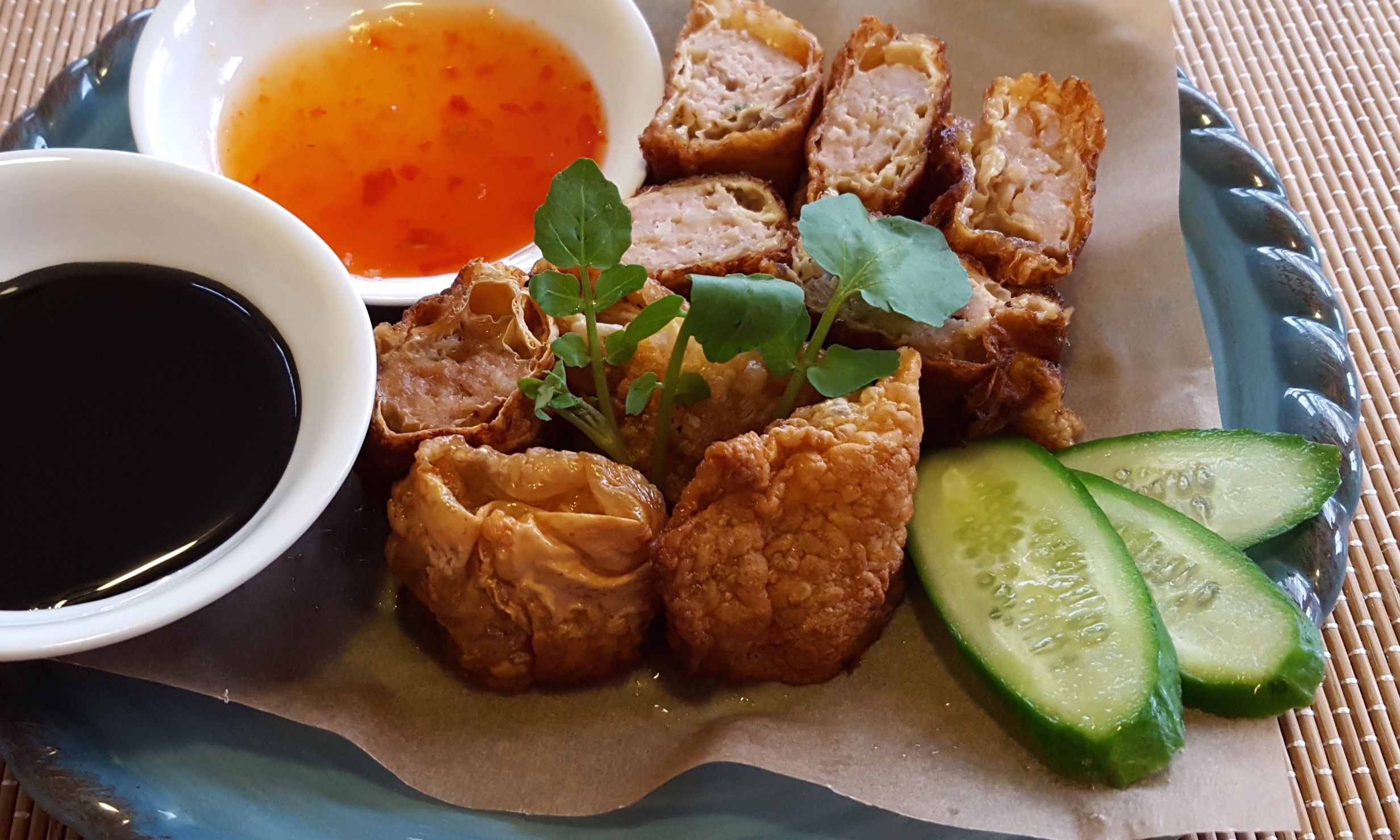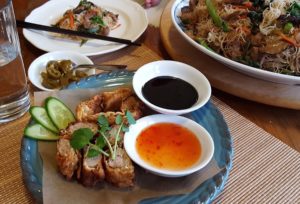
Here’s a Recipe Challenge I received months ago but was too busy to get to. Blame it on my cutest new grandson! Sincere apologies to Cheryl Tran, who asked for something “robust, classy and flaky.”
So Cheryl, I decided to stay with Asian. I made Ngoh Hiang. I figured a pork and shrimp very robust filling seasoned with sesame oil and five-spice powder, wrapped in delicate, flaky bean curd skin served as an appetizer for your buddies would be classy enough. I think the bean curd skin makes it very different. For more on bean curd skins, click here. You won’t find this lovely appetizer in too many restaurants in our area.
Ngoh Hiang, also called Lor Bak, is a Hokkien specialty. It’s special this way; the rolls are first steamed and then deep fried. These have the best ingredients including shrimp or crab. And classy is also how you present it, right, Cheryl?
Ngoh Hiang at its simplest level is eaten as a snack or side dish. Commonly found in Singapore food courts, Ngoh Hiang is sometimes served with a selection of other snacks like deep fried fish balls, a sweet sausage, or prawns fritters. As a breakfast food it comes with your choice of fried wheat or rice noodles, veggies and maybe fried egg. (I served it for dinner with fried bee hoon, rice vermicelli. You can see it in the picture above. )
As this is so easily available this is not something many people make at home in Singapore. The process, in my opinion, is also laborious. So why would anyone make it? (Except for a Recipe Challenge!)
I understood why after watching my Uncle Hock, home cook extraordinaire, make it. I can vouch that his Ngoh Hiang is like no other. It’s the stuff he puts in which is far superior than any version sold in food stalls.
It’s kind of like comparing mass produced chicken pies to the ones you make yourself. Mass produced chicken pies may give you two pieces of chicken and a lot of potato. You get the idea.
Home made Ngoh Hiang may be stuffed with ground pork, shrimp or crab, liver, mushroom, chestnut, bamboo and whatever creative additions. Those at the food stalls have more cornstarch filler than the little meat and shrimp they put in. (But it’s still tasty!) Hokkien restaurants known for their Ngoh Hiang starters also have much better quality filling. Those are so delicate and delicious!
A vegetarian version can be made with different types of mushrooms, bamboo, carrot, cabbage and hard-pressed tofu.
My mistakes
I must confess that I should probably do this over again. I haven’t done Ngoh Hiang in years and made a few mistakes doing these. But after taking the photos and making adjustments, I thought they looked good. They tasted good, Alison said.
Mistakes are great learning opportunities in the kitchen so I’ll share mine so you won’t make them. Firstly, roll them so that they are tight and round. Mine looked a little oval, not as attractive I think. Secondly, I made the lazy mistake of putting them in two layers to steam. The bottom layer didn’t cook very well. I had to remove the top layer and do over.
Also I thought 10-15 minutes of steaming was enough but when I cut it through, the center was still raw-ish. As I discovered this, I remembered (too late) when Uncle Hock did this, he steamed one, cut it open and tested it. Full confession, I discovered this after I fried the rolls which made me want to kick myself. So since I couldn’t steam and fry it again, I baked it in the oven. (Head hanging down…) My bad! Mine would look better if I did it the way I’ve written below!
To prevent having raw pork, steam wrapped rolls for at least 25 minutes. The meat inside should be completely cooked and edible after steaming. Cut through one just to be sure. Cool and drain well before frying.
When frying make sure you have enough oil to submerge the whole roll. Select a deep frying pan large enough to hold one or two rolls. You can make the rolls shorter than the five inches that I suggested.
When you fry the cooled rolls, be prepared to work quickly moving it in and out of the hot oil. The frying is basically only to give the Ngoh Hiang a nice, crispy skin. Don’t expect the frying to help you cook the inside filling. The heat won’t have time to penetrate into the filling. The bean curd skin browns very quickly so be ready to take it out efficiently. Have tongs or a slotted ladle and your dish with kitchen towel for draining nearby.
Ngoh Hiang (Deep Fried Bean Curd Skin Rolls)
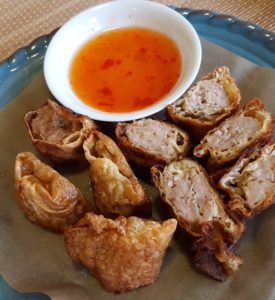
Makes 8 rolls (40 pieces)
Preparation time: 45 minutes
Cooking time: 30 minutes of steaming, about 45 minutes to drain and cool and 15 minutes to deep fry
2 large sheets of bean curd skin
Water for steaming
2 cups oil for frying
Filling
6 ounces (150 grams) prawns, peeled, deveined and chopped
12 ounces (300 grams) ground pork
8 water chestnuts, peeled and finely chopped (optional)
2 tablespoons minced onion
2 stalks spring onions, finely chopped
Marinade for filling
¼ teaspoon salt
dash of five-spice powder
1 tablespoon light soy sauce
dash of sugar
1 teaspoon sesame oil
½ egg
dash of pepper
1 teaspoon cornstarch
Condiments
Bottled Thai Sweet Chili Sauce
Bottled Sweet Dark Soy Sauce
Making the filling
In a large bowl, combine prawn, pork, water chestnut, onion and spring onion.
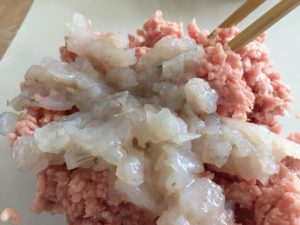
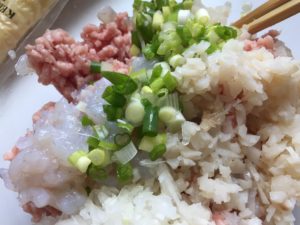
Add salt, five-spice powder, light soy sauce, sugar, sesame oil, egg, pepper and cornstarch. Mix well and set aside for 30 minutes.
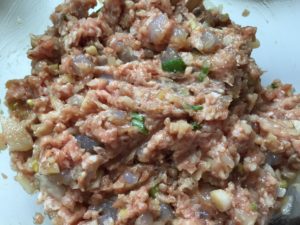
Wrapping the rolls
Cut two large circles of bean curd skin into four quarters each. Lay bean curd skin on work counter. If skin is dry, wet the bean curd skin with a clean, damp cloth, to moisten and soften. (If skin is pliable, this wetting process is not necessary.)

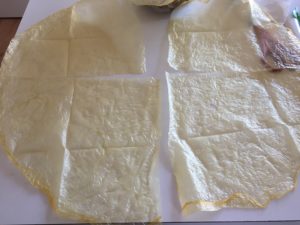
Divide the filling into eight portions and place one portion in a roll along the bottom length of one of the quarter bean curd skins. Leave some space from the bottom and on the left and right edges. The roll of meat should be about 5 inches (12 cm) long.
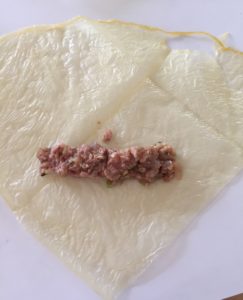
Lift the bottom edge of the skin over the filling and wrap skin firmly over the meat to form a round roll. Squeeze it gently not to pack the meat in but so there are no air pockets between the skin and filling.
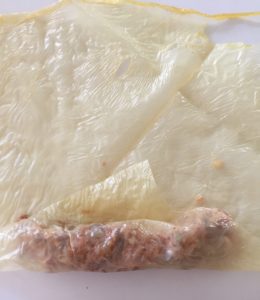
Fold the left and right sides over.
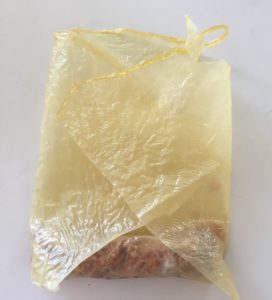
Continue to roll and wrap over the filling until it reaches a third of the square.
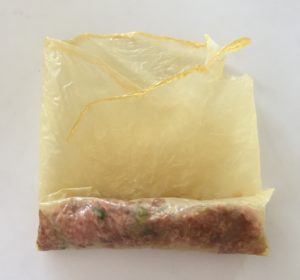
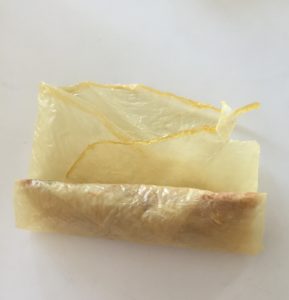
Keep rolling the wrapped meat upwards until it reaches the top edge. Turn the roll over so that open flap is held in place by its own weight.
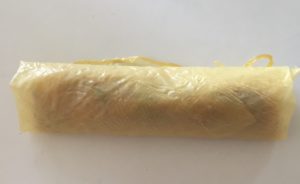
Set roll aside in a deep, heatproof dish. Continue to wrap the remaining sheets with the rest of the filling. Place rolls in one layer in the dish. (You may also steam rolls in two levels of double layer bamboo steamer. Or steam them in two batches.)

Steaming the rolls
Fill a wok with water about 2 inches (5 cm) deep and bring to a boil. When water is boiling, place dish of stuffed rolls on top of a steaming rack in the wok and steam covered on medium-high heat for 25 minutes. Transfer and drain rolls on a rack and cool for 20-30 minutes. Discard water and dry wok.
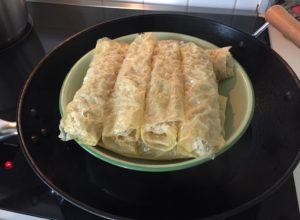
Deep frying rolls
Heat oil in wok for deep-frying. To test if oil is hot enough, dip one end of a chopstick into the oil and when bubbles start to form at its tip, the oil is ready for frying.
Add rolls one or two at a time and fry on medium heat until it is evenly browned on all sides.
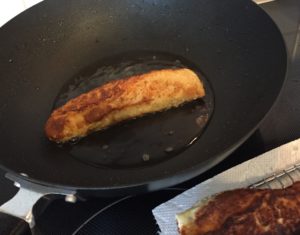
Set on paper kitchen towels to absorb oil. When cool, slice bean curd rolls crosswise or at an angle into pieces and serve with chili and sweet dark sauces.
NOTES
Variations
Different ingredients
–Instead of meat, you can make vegetarian Ngoh Hiang using shredded bamboo, carrots, cabbage, Chinese, shitake or enoki mushrooms, and extra-firm or pressed tofu. Marinate with the same seasoning.
Banquet Presentation
Plating Ngoh Hiang
–These make great starters. Place attractively on top of doily or parchment paper. Offer a selection of condiments for dipping—sweet Thai chili sauce, or a sweet thick soy sauce. Garnish with slices of cucumber.
–Serve in a combination platter: Serve Ngoh Hiang with any 2 or 3 of these Cold Dishes: Pickled Cucumber, Pickled Cabbage, Chilled Prawns in Mustard Dressing and/or thousand-year-old eggs.
